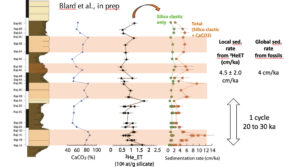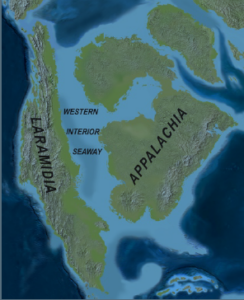PhD thesis in CRPG Nancy, France (October 2022-September 2025) – FILLED POSITION
Advisors:
Pierre-Henri Blard (DR-HDR, CRPG Nancy – geochemistry, geochronology) 60 %
Baptiste Suchéras-Marx (MdC, CEREGE Aix-en-Provence – sedimentology, paleontology) 20%
Guillaume Suan (MdC, Université de Lyon – sedimentology, geochemistry) 20%
Salary: 1975 €/month
Application: Send a CV (3 pages maximum), a motivation letter and 1 (or 2) recommendation letter(s) before June 15th 2022
to the 3 advisors: blard@crpg.cnrs-nancy.fr ; sucherasmarx@ cerege.fr ; guillaume.suan@univ-lyon1.fr
Important: your application will also need to be uploaded on the ADUM SIRENA portal:
Mobility: The PhD student will perform a significant part of his/her work at CRPG Nancy (about 60%).
However, the PhD will also undertake analytical and research work in the two other labs, CEREGE Aix-en-Provence (about 20%) and University of Lyon (about 20%).
Advisors will provide financial support to the student to cover his/her travel and accommodation additional expanses.
During the first year of the PhD thesis, we will organize a field trip in the Western USA to analyze and sample marl-limestone Cretaceous sections.
Requested skills: geology, sedimentology, geochemistry, paleontology, numerical methods and statistics
Detailed description of the PhD topic:
Marl-limestone sub-metric cyclic alternations are sedimentary features that are encountered in most pelagic and hemipelagic Phanerozoic environments (Einsele, 1982).
Cyclostratigraphers have today established that these lithological alternations are paced by the variability of the Earth’s orbit (astronomical cycles), that have proper periods of 22, 41, 100 and 405 ka (Milankovitch, 1941). However, the sedimentological mechanisms that drive these marl-limestone alternations are still discussed and may vary from a sedimentary basin to another.
Different hypotheses have been proposed (Einsele, 1982): (i) some authors suggest that the silico-clastic flux is constant during through these cycles, while carbonate deposition flux is variable (e.g., Van Os et al., 1994; Pittet and Mattioli, 2002), (ii) according to
other authors, the carbonate flux is constant while the terrigeneous flux, driven by astronomical forcing on continental rainfall, is variable (e.g., Mount et Ward, 1986 ; Locklair et Sageman, 2008).
This debate has not been solved yet, notably because existing geochronological methods (biostratigraphy and cyclostratigraphy) lack the required temporal resolution (<5 ka) to detect and quantify the variations of the deposition fluxes between marl and limestone strata.
In a recent pilot study at CRPG Nancy, we tested, for the first time, the use of extraterrestrial 3He (3HeET) at the scale
of marl-limestone alternations in Mesozoic sediments. These preliminary data are very promising: they show that this geochronological tool may be used to measure the respective detrital and carbonate flux in this context, at a resolution better than 5 ka (Fig. 1). 3HeET is delivered to Earth by Interplanetary Dust Particles (IDPs) at a flux that may be considered as constant over timescales shorter than 100 ka (e.g. Farley et al.,2012).
Hence, measuring the concentration of 3HeET in sedimentary deposits permits to constrain the sedimentation rates,
at a better resolution than the orbital timescales (< 5 ka).
Since the protocol also measures the CaCO3 content of each sample, this method precisely
determines the relative and absolute silico-clastic and carbonate fluxes.
Our pilot study was conducted at high resolution over 3 marl-limestone duplets (3.5 m long) of a Bajocian section in Barles (Southern Alps, France) and over 1 marl-limestone cycle (90 cm long) of a Valanginian section (Fig. 1).
These 3HeET-constraints fluxes show that, in this epicontinental sedimentological environment of the Tethys Ocean, the silico-clastic
terrigenous flux remained constant, while CaCO3 deposition varied cyclically, high carbonate production hence “diluting” the other components (SiO2, organic carbon COT) (Fig. 1; Blard et al., Dingue, 2021 ; Blard et al, in prep. for EPSL).
Nannofossil analysis also showed that this CaCO3 production is in majority a mudstone material derived from nearby carbonate
platforms, and not from pelagic bioproduction.

Figure 1 – 3HeET determination of the silico-clastic and carbonate fluxes along 3 marl-limestone sedimentary duplets sampled in a Bajocian sedimentary section (Barles, Southern Alps, Haute-Provence, France) (Blard et al., in prep).
However, other more proximal sedimentary environments might be controlled by other processes.
In particular, the well-studied marl-limestone Cenomanian-Turonian deposits of the Cretaceous Western Interior Seaway (KWIS; Fig. 2) are interpreted as the results of variable terrigenous inputs in the proximal part of the basin, while the CaCO3 is supposed to control the lithological variability in the distal part of the basin (Eldrett et al., 2015). In the Coniacian-Santonian section, silico-clastic variations could drive the observed sedimentological alternations, even in the distal part of the basin (Loklair and Sageman, 2008).

Figure 2 – The Cretaceous Western Interior Seaway – KWIS (Blakey, 2008)
During this PhD thesis, the student will analyze 3HeET at high resolution in wellcharacterized sedimentary
outcrops and cores sections of the Cenomanian and Turonian, comparing different environmental and paleogeographic situations (2 proximal and distal sections in the KWIS + 1 or 2 IODP cores in deep basins).
To test the existing hypotheses, we propose to analyze at least 10 marl-limestones
duplets per site, at a sampling resolution of at least 3 samples per 10 ka. This sample strategy
will ensure a high statistical power and should permit to detect potential frequency variations
(through Fourier analysis). Major and trace elements, TOC, d13CTOC and d13CCaCO3 will also be
measured. The variability of these data will be complementary cyclostratigraphic insights,
both to define the variability trends and identify the main processes. The fossil fauna, the
mineralogy, as well as the origin of CaCO3 will also be determined by nannofossils and
microfossils counting at CEREGE (Aix-Marseille University, supervision B. Suchéras-Marx) and
at LGL-TPE (Lyon 1 University, supervision G. Suan).
Finally, the PhD students will also tackle a riskier subsidiary question. He/she will try
to provide new data to make progress on our understanding of the anoxic event that occurred
at the end of the Cenomanian (OAE2). This oxygenation crisis of the ocean is thought to have
lasted between 350 and 850 ka (Boulila et al., 2020 and references therein). This crisis would
have resulted from an extreme fertilization event, that led to the massif deposit of TOC-rich
marls (black shales), finally leading to the O2 depletion of the ocean. Consequently, marine and CaCO productivity probably collapsed. However, several hypotheses are still debated,
notably about 1) the nature of the trigger event (volcanic eruption, meteorite, sea level
changes, global warming) and 2) the duration of the recovery of the ocean-biosphereatmosphere
coupled systems.
With the new 3HeET from the Cenomanian study as a background, the PhD Student will
analyze the 3HeET at high resolution in the Cenomanian-Turonian transition, as an attempt to
better constrain the timescale of the different phases of the OAE2 event. Along with the
measurement of Hg, Ir, PGE, TOC and other geochemical proxies, these new data will bring
information about the nature of the trigger event (volcano, meteorite) as well as the durations
of the OAE2 crisis, and the one of the recovery phase posterior to the crisis climax.
References
Blakey, R.C., 2008. Gondwana paleogeography from assembly to breakup-A 500 m.y. odyssey.
Geological Society of America Special Papers 441, 1-28. 10.1130/2008.2441(01)
Boulila, S., Charbonnier, G., Spangenberg, J.E., Gardin, S., Galbrun, B., Briard, J., Le Callonnec,
L., 2020. Unraveling short- and long-term carbon cycle variations during the Oceanic Anoxic
Event 2 from the Paris Basin Chalk. Global and Planetary Change 186, 103126.
https://doi.org/10.1016/j.gloplacha.2020.103126
Einsele, G., 1982. Limestone-Marl cycles (periodites): Diagnosis, significance, causes – a
review, in: Einsele, G., Seilacher, A. (Eds.), Cyclic and event stratification. Springer, Berlin
Eldrett, J.S., Ma, C., Bergman, S.C., Ozkan, A., Minisini, D., Lutz, B., Jackett, S.-J., Macaulay, C.,
Kelly, A.E., 2015. Origin of limestone–marlstone cycles: Astronomic forcing of organic-rich
sedimentary rocks from the Cenomanian to early Coniacian of the Cretaceous Western
Interior Seaway, USA. Earth and Planetary Science Letters 423, 98-113.
https://doi.org/10.1016/j.epsl.2015.04.026
Farley, K.A., Montanari, A., Coccioni R., 2012. A record of the extraterrestrial 3He flux through
the Late Cretaceous. Geochimica et Cosmochimica Acta 84, 314-328.
Locklair, R.E., Sageman, B.B., 2008. Cyclostratigraphy of the Upper Cretaceous Niobrara
Formation, Western Interior, U.S.A: a Coniacian-Santonian orbital timescale. Earth and
Planetary Science Letters 269, 540-553
Milankovitch, M., 1941. Kanon der erdbestahlung und seine anwendung auf das
eiszeitproblem. Königlich Serbische Academie 133, 633 pp.
Mount, J., Ward, P., 1986. Origin of limestone/marl alterations in the upper Maastrichtian of
Zumaya, Spain. Journal of Sedimentary Research 56, 228-236. 10.1306/212F88C8-2B24-
11D7-8648000102C1865D
Pittet, B., Mattioli, E., 2002. The carbonate signal and calcareous nannofossil distribution in an
Upper Jurassic section (Balingen-Tieringen, Late Oxfordian, southern Germany).
Palaeogeography, Palaeoclimatology, Palaeoecology 179, 71-96
Van Os, B.J.H., Lourens, L.J., Hilgen, F., De Lange, G.J., Beaufort, L., 1994. The formation of
Pliocene sapropels and carbonate cycles in the Mediterranean: Diagenesis, dilution, and
productivity. Paleoceanography 9, 601-617



